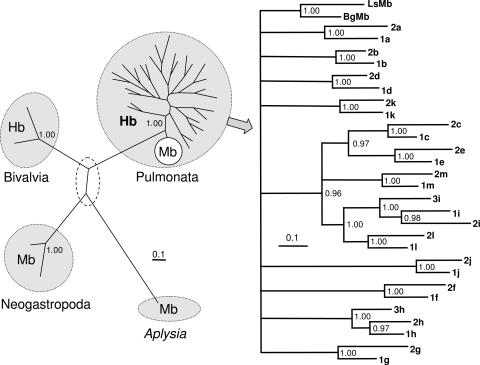Fig. 4.
Molecular phylogeny of hemoglobin domains (Hb) and myoglobins (Mb) from mollusks. Note in the left unrooted tree the very large phylogenetic distance between pulmonate hemo/myoglobins on the one hand and other molluscan hemo/myoglobins on the other hand. (The branching order within the dashed field is not well supported.) Note that in the right tree, which has been rooted with the two Mb sequences, the topologically corresponding globin domains from the two polypeptides BgHb1 and BgHb2 are more similar to each other than any two domains within either BgHb1 or BgHb2, thereby indicating that the two polypeptides diversified by a single gene duplication event. The two as-yet-sequenced additional domains indicate a third polypeptide (BgHb3). The trees suggest that planorbid hemoglobin evolved by a series of gene duplications and fusions from an ancestral planorbid myoglobin. Posterior probabilities >0.95 are indicated at each node of the rooted tree. Nodes with lower supporting values are collapsed. The different BgHb domains are labeled according to the alignment of Fig. 3. Bg, B. glabrata; Ls, L. stagnalis; 1a–1m, domains BgHb1a to BgHb1m; 2a –2m, domains BgHb2a to BgHb2m; 3h and 3i, domains BgHb3h and BgHb3i

